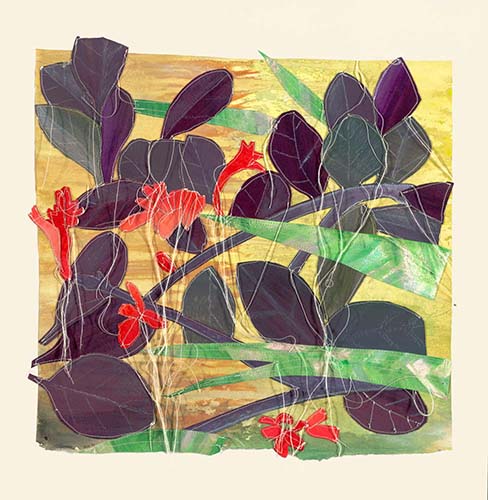Sara Everett’s paintings include a distinct process of destruction; she cuts and tears her paintings apart. The destroyed painting then becomes the fabric of something new, which is literally mended into sewn collages of endangered animals, plants or landscapes.
With canvas or paper, the sutures holding these pieces together have repaired the damage, but the mending is visible. Her pieces act as totems for species and places that are barely hanging on by a thread.

Everett’s work has been shown in Seattle galleries and internationally in Ireland, Finland and Monaco. She has been an awardee of the Vermont Studio Center Artist Fellowship and a printmaking residency in Co. Donegal, Ireland.
As well as being a working painter, she also consults as a curator for real estate development in the Seattle area, and serves on the Board of Directors of Seattle’s Uptown Arts District.
What do you first do when you get to the studio?
Turn on the tunes! Music is an important part of my process.
How many paintings do you work on at a time?
2-3, depending on where I am in my multi-layered process. A color play abstract painting usually later becomes parts of several pieces. And I’ll often create my compositions in batches of three or four. But I can only stitch one piece at a time when it comes to the finish.
Do you have a dream project that you would like to work on?
A large scale, permanent installation for a public space and be paid for the insane amount of work something like that actually is.
If you could paint with anyone, who would it be?
Georgia O’Keefe.
What’s your favorite way of generating ideas and inspiration?
Travel – Pacific Northwest near or beyond. My favorite way to get to know a new landscape is to sketch it in watercolor pencil. These watercolor gestures often become larger works once back to the studio.
How has your art evolved over time?
I used to be a hyper-realist painter but kept getting inspired by abstraction. I would spend countless hours painting feathers and animal fur for portraits but my sketchbooks would tell a story all of abstract washes and line gestures. Eventually I found a way to find union between my muses by tearing paintings in order to create a composite landscape background, which grew into fully formed pieces from there.
Knowing the intent is to tear or cut my paintings allows me to let go of the outcome of each painting session and just enjoy the process. I love the unpredictability of experimentation and then taking those experiments beyond their chaotic beginnings back into something recognizable, while still maintaining a playful nature.
What do you like most about your work?
The process I’ve created for myself. Between all the different stages my work goes through before it becomes a finished piece I’m continually reinspired. I also love connecting viewers to that process when talking about my work, and seeing them light up with their own inspirations.
What is one word that best describes your style?
Colorful.
Is there an idea you would like to explore?
I want to research and create a series around keystone endangered plants.
What is your favorite time of day to paint?
Whenever I can! But I seem to find the most “flow” from afternoon to early evening.
Do you ever get “stuck” on a piece?
Simple – swap to a different piece or different phase of my process! If I’m stuck in a painting I’ll swap to making collage studies, or stitching. It’s all very creatively sustainable for me. My primary problem has always been that there never seems to be enough time for all the ideas.
What is up next on your easel?
I’ve been working on a large-scale piece of the Perito Moreno glacier (10’ h x 8’ish) for a few months now involving time-based painting with cyanotype to achieve four different tones. It’s been the most ambitious piece I’ve tackled to date in process and scale and I’m loving how it is starting to come together. I’ll have my fill of blue when it’s done though, and am looking forward to getting back to the full spectrum of colors!
Click here to see more of Sara’s work!


